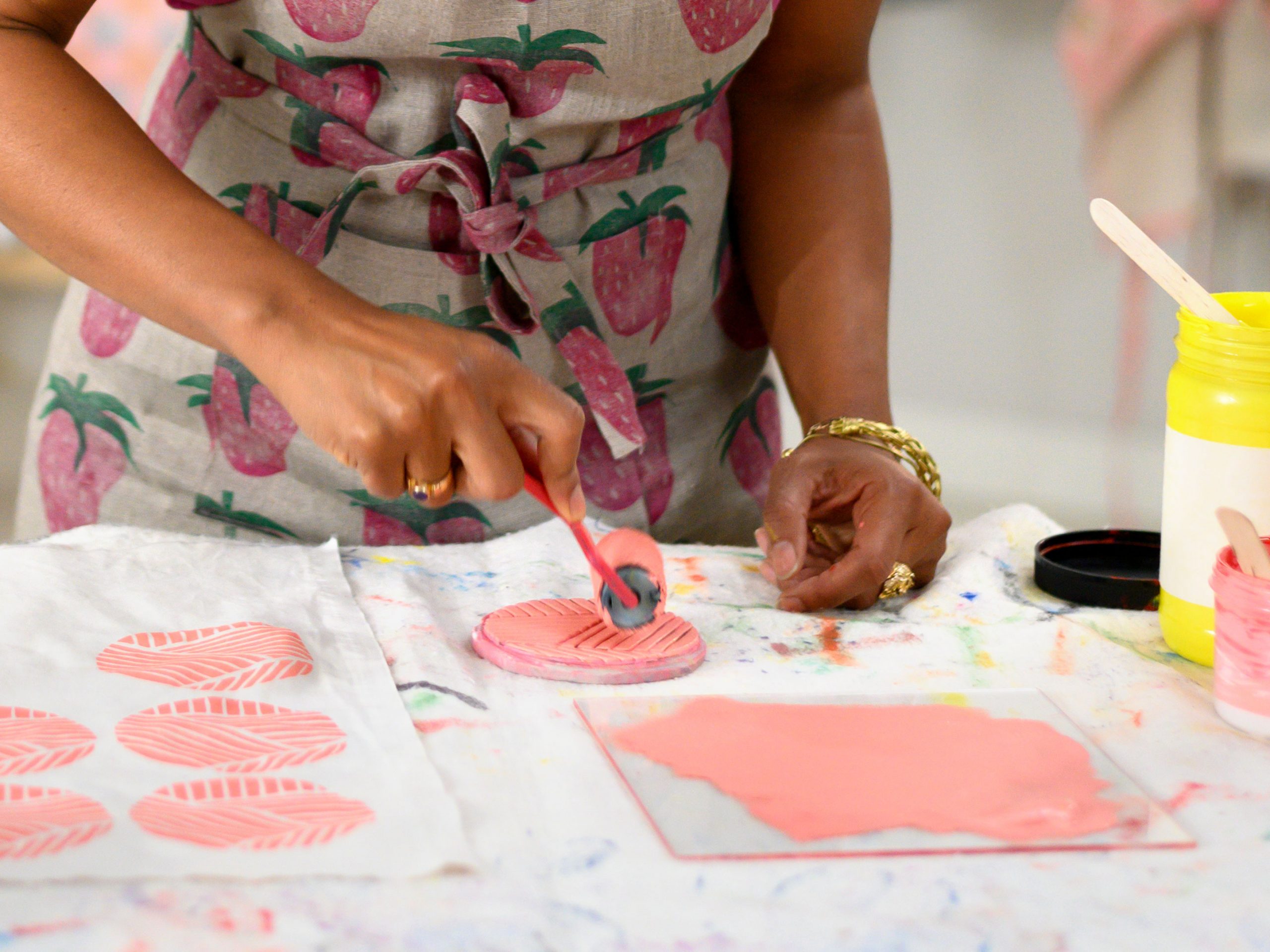
Say buh-bye to the days of searching for that perfect bolt of fabric. Block printing is the easy way to create custom fabrics for one-of-a-kind sewing, quilting and home decor projects. If you’re new to customizing fabrics, Jen Hewett, textile artist and instructor of Fabric Design: Block Printing, has must-know tips for beginners.
Choosing Fabric
Not all materials are created equal. Here’s what you need to know before shopping.
Fabrics to Use
Plant-based ink is a go-to when block printing, and it works best with cotton, linen, hemp, bamboo, polyester and, in some cases, nylon. For true beginners, Hewett says to use blank, unprinted fabric so the ink absorbs evenly. (Boundless Cotton Fabric is a great option.) You should also stick to light-colored fabrics — the ink is a bit translucent, so printing on darker fabric won’t give the desired result.
Fabrics to Avoid
Hewett recommends staying away from animal-based fabrics (such as silk or wool) and commercially printed fabrics, as the ink won’t bind well. She also says to avoid canvas, twill or any fabric with a highly textured weave. These fabrics will impact the print by highlighting the texture and distracting from your design.
Prepping Your Fabric
You’re eager to get printing, but wait! There are a few steps to take before you begin.
Iron Linen
If you’re block printing on linen, you might run into some literal wrinkles. Before you pre-wash, Hewett recommends ironing on the highest possible heat setting with no steam. After that, wash on hot and dry on high. Doing so will make the material much easier to work with and it won’t wrinkle nearly as much.
Prevent Fraying
There’s nothing worse than fraying fabric, so if you’re working with material that’s prone to ravels, Hewett says to pink or serge the raw edges before washing and drying.
Pre-Wash, Pre-Wash, Pre-Wash
No matter what fabric you use, Hewett says pre-washing is vital because it removes the sizing, aka a finish added to fabrics during manufacturing that impacts whether or not your ink binds well. She suggests pre-washing fabric on the highest possible heat before either line drying or tossing in the dryer.
Building Your Block

The block you use is just as important as your fabric. Here’s how to choose the right one.
Types of Blocks
Soft blocks and linoleum are two popular options used in fabric printing. Soft blocks are more beginner-friendly because they’re easy and fast to carve, plus Hewett says you can use water-based inks. Linoleum requires more effort and time, so if you’re itchin’ to get printing it’s best to opt for the softer version.
Small vs. Large Blocks
When choosing a block size, bigger isn’t always better. Hewett says beginners should start printing with a block that’s about the size of your hand, or 4″ x 6″. Large blocks can be difficult to maneuver and can weaken in the middle as you print repeats, which can cause cracks in your pattern.
Creating Compelling Designs

You don’t need to be a master artist to block print your own fabric. Here’s what Hewett says to keep in mind when crafting your own design.
Stick With Simplicity
Basic shapes printed in repeats and in multiple colors often make the best designs. And the larger blocks of color your design has, the better. Just be mindful of fine lines: in Hewett’s designs, she avoids patterns that have a fine line or carves them away to leave white space as she prints. Soft blocks don’t hold fine detail well, so smaller elements may not come out as you hoped.
Sketch It Out
Work out the design on paper first, as any mistakes made when carving are difficult to remove. When planning the print, remember the block will be the mirror image of your design and plan accordingly. It’s also helpful to shade in the areas that will print in your sketch — Hewett recommends shading the entire shape first, then removing detail with your eraser (essentially creating a reductive drawing).
Size It Right
Obviously, the image you want to print cannot be any bigger than your block. So make sure your sketch is sized for success — Hewett suggests tracing your block onto your paper so you know the dimensions, then sketching the design inside. Just remember to keep the design at least ⅛” away from the edges so there’s room for your repeats.
Work One Color at a Time
Even if your design requires two colors, like the block printed strawberry Hewett makes in her class, you should only have one color on your block at a time. This is super important because colors tend to bleed into each other — if you stamped the red berry and the green stem at once, you’d end up with a muddy mess.

Can you block prints on outdoor fabrics? I want to start my own outdoor textile line.
Love to learn block print
Mine is a startup clothing brand on Instagram, I would like to order a stamp of my logo along with colours , so that I could block print it on the bags , covers etc! Please help
I just had a go at printing the circle design on plain cotton fabric. Vow! I had very different tools but thought I should have a go anyway. I had a very thin much smaller lino which I printed the pattern at %50 and carved. I also used rubber roller. It came out great! I will definetly try the furry roller and rubber stamp in the future. Thank you for this video. It is fantastic!
Can't wait to start I make my own cushions but want to branch out in own business bedding own designs,
What would you recommend as a alternative to soft blocks, sadly they are not available in my country
Me encantaría aprender técnica de estampado
Always wanted to do this
Love to learn Block printing
I like to ask that which color I should use for block printing